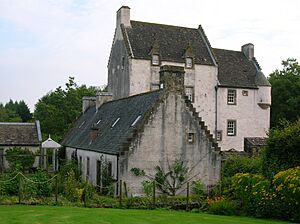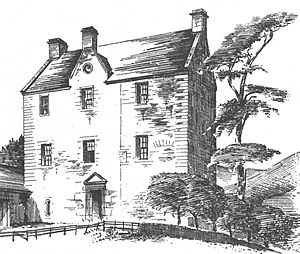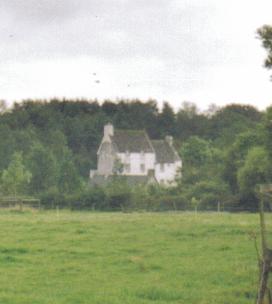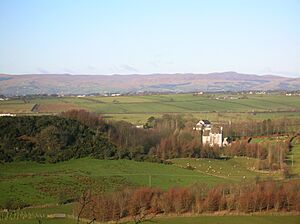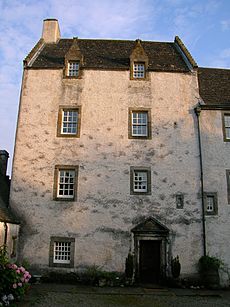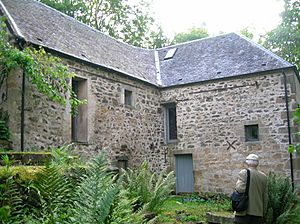Baron of Aiket facts for kids
The Baron of Aiket was a special title in old Scotland. It belonged to the person who owned the Barony of Aiket. A barony was like a large area of land, similar to a small kingdom, that came with a castle. Aiket Castle and its lands were in a place called Cunninghame, which is now part of East Ayrshire, Scotland. This title no longer exists today.
Contents
Aiket Castle: A Historic Home
Aiket Castle was a four-story stone tower. It was a common type of home for important land owners. The Cunninghame family built it around 1479, soon after they got the land. The castle was once surrounded by a moat, which was a ditch filled with water for protection.
After a sad event where the 4th Earl of Eglinton was killed, Aiket Castle was damaged. It was then rebuilt and made bigger in 1592. Later, in 1734, the castle was sold. The new owners tried to make it look like a grand, modern house. They even removed the top floor!
In the early 1600s, the Dunlop family owned the castle. Much later, it was used to house farm workers. In 1957, a fire badly damaged the building. But don't worry, it was restored to look like it did before 1734. This restoration work was so good that it won an award in 1987! The name 'Aiket' actually means 'Oak Wood'.
Near Aiket Castle, there's a place called Barr Hill. It used to have two tall stone monuments on top until the early 1800s. These structures were well-built and stood about twelve feet high.
Like many old baronies, Aiket had a special place called a Justice Hill. This was where the local court met outdoors to settle disagreements. You can still see it marked on old maps near the castle.
The Cunninghame Family of Aiket
The Cunninghames who lived at Aiket were part of a larger family. They came from the Cunninghames of Bedlands, who were a branch of the powerful Cunninghames of Glencairn.
Alexander Cunninghame is the first person recorded as living at Aiket. He received a special document from the King in 1479. This document officially gave him ownership of the land. Before him, Elizabeth Cunninghame had given the lands away without the King's permission.
The Legend of the Spectral Knight and the Bride of Aiket
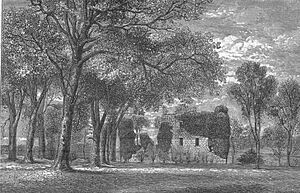
There's a famous old story about Aiket Castle. It tells of a young woman named Anna Cunninghame of Aiket. She was in love with Henry Montgomerie of Hessilhead. They promised to marry when he returned from a long journey called the Crusades.
While Henry was away, a man named Allan Lockhart, from a nearby family, started visiting Aiket Castle often. He wanted to marry Anna, but she loved Henry. Allan knew he wouldn't succeed unless Henry never came back.
After many months, Allan came up with a trick. He convinced a soldier who had returned from the Crusades to tell a false story. The soldier said that Henry Montgomerie had died. Anna believed the sad news. After a short time, Allan tried again to win her over, and a wedding day was set.
But on that very wedding day, Henry returned to Hessilhead Castle! He found out about Allan's trick. Henry quickly rode towards Aiket Castle to claim his bride. Sadly, he fell from his horse and died within minutes.
The legend says that at midnight, the wedding party at Aiket Castle suddenly stopped. A figure appeared, fully dressed in shining armor. It was Henry Montgomerie! He lifted Lady Anna and then vanished into the night. The story says that neither Henry nor Anna were ever seen again.
A Real Story Behind the Legend?
History records some facts that might be connected to this legend. A man named Montgomerie of Hessilhead was supposed to marry a young woman named Anna Inglis. Her mother later married Allan Lockhart.
Allan Lockhart forced his step-daughter, Anna, to marry William Cunningham of Aiket. William was Allan's cousin. William received a large sum of money as part of the marriage agreement. Anna later asked for a divorce, and she succeeded in 1641.
Aiket Mill: Grinding Grain by Water
There was a corn mill on the Glazert Water near Aiket Castle. It first appeared on maps around 1890. This old mill has been fixed up and is now used as a home. The large waterwheel that once powered it is no longer there.
However, you can still see several old millstones at the site. The channel that carried water to the mill, called the mill race, is still in good condition. Another mill, Bloak Holm mill, was located nearby on the Glazert Water.
The millstones at Aiket were made from special French stone called French Burr. These stones came in pieces, like a puzzle. The millwright, who built and fixed mills, had to fit them together. Once assembled, strong iron bands were fitted around them. These bands were heated so they would expand, then placed around the stones. As they cooled, they shrank, holding the stone pieces tightly together. The stones were also sealed with plaster to keep them strong and clean.
Braikenheuch Hill: A Place of Old Feuds
This hill is about a mile and a half from Dunlop. Its name, Braikenheuch, means 'Bracken Crag'. It's said that a Cunninghame of Aiket was killed here by a Montgomerie. This happened during the time when these two families had many disagreements and fights. Today, this area is known as the 'Brechna Braes'.
More About Aiket
The gardens around Aiket Castle have been beautifully designed. Old stones were reused for steps, and the area of an old quarry was turned into a lovely landscape. Many ornamental trees and shrubs have been planted there.
In 2011, Aiket Castle was put up for sale.


